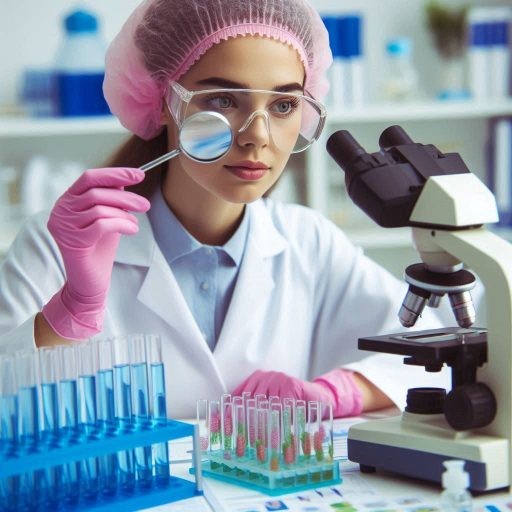Introduction
Advancements in microbial genomics research have transformed our understanding of microorganisms.
This field studies the genetic material of microbes, including bacteria, fungi, and viruses.
Recent technological innovations have accelerated genomic sequencing, making it faster and more affordable.
These breakthroughs have opened new avenues for research and application across various sectors.
Microbial genomics plays a crucial role in healthcare.
Understanding microbial genomes helps researchers identify pathogens more quickly.
This knowledge improves diagnostic methods and informs treatment options.
For instance, genomics has enhanced our ability to track and combat antibiotic-resistant bacteria.
By analyzing genetic variations, scientists can determine resistance mechanisms and develop targeted therapies.
In agriculture, microbial genomics significantly impacts crop production and soil health.
Scientists study the genomes of beneficial microbes that enhance plant growth.
These microbes can improve nutrient absorption and increase resistance to diseases.
Genomic research also aids in developing biofertilizers and biopesticides.
These sustainable alternatives reduce reliance on chemical inputs, promoting environmental health.
Environmental science benefits greatly from advancements in microbial genomics.
Microorganisms play a vital role in nutrient cycling and ecosystem functioning.
Understanding their genomes allows researchers to monitor environmental changes more effectively.
For example, genomics can identify microbial communities in polluted environments.
This information guides bioremediation efforts to restore contaminated sites.
Overview of Microbial Genomics
Microbial Genomics and Its Significance in Studying the Genetic Makeup of Microorganisms
Microbial genomics is the study of the genetic material of microorganisms.
It includes bacteria, archaea, fungi, and viruses.
This field focuses on sequencing, analyzing, and interpreting microbial genomes.
By understanding these genomes, scientists can uncover how microorganisms function, adapt, and evolve.
The significance of microbial genomics lies in its ability to enhance our understanding of life at the microscopic level.
Microorganisms play essential roles in ecosystems, human health, and industry.
They contribute to nutrient cycling, disease processes, and biotechnology applications.
Microbial genomics allows researchers to explore these vital roles in detail.
The Role of Microbial Genomics in Understanding Microbial Diversity and Evolution
One of the key contributions of microbial genomics is its ability to reveal microbial diversity.
Traditional methods of studying microorganisms often rely on culturing techniques.
However, many microorganisms are unculturable, making it difficult to understand their genetic diversity.
Microbial genomics overcomes this limitation by analyzing environmental samples directly.
Researchers can sequence DNA from complex microbial communities.
This approach enables them to identify and characterize previously unknown species.
Understanding microbial diversity is crucial for various reasons.
It informs ecological studies and helps scientists assess the health of ecosystems.
Microbial genomics also aids in understanding the relationships among microorganisms.
By analyzing genetic similarities and differences, researchers can reconstruct evolutionary histories.
This information sheds light on how microorganisms have adapted to different environments over time.
In addition to diversity, microbial genomics provides insights into microbial evolution.
Researchers can track genetic changes in populations over generations.
This capability helps in understanding how microorganisms respond to environmental pressures.
For example, studying antibiotic resistance in bacteria relies heavily on genomic data.
Scientists can identify genetic mutations associated with resistance, paving the way for new treatment strategies.
Microbial genomics also impacts fields beyond ecology and evolution.
It plays a crucial role in medical microbiology, agriculture, and environmental science.
In medicine, genomics aids in the identification of pathogens and understanding their virulence factors.
This knowledge enhances diagnostic tools and therapeutic approaches.
In agriculture, microbial genomics contributes to the development of biofertilizers and biopesticides.
Understanding the genetics of beneficial microorganisms can lead to sustainable farming practices.
In environmental science, researchers use microbial genomics to monitor and remediate contaminated sites.
By understanding microbial communities, scientists can design effective bioremediation strategies.
In short, microbial genomics is a vital field that enhances our understanding of microorganisms.
It reveals microbial diversity and elucidates evolutionary processes.
By studying the genetic makeup of microorganisms, researchers can unlock new knowledge in various domains.
This knowledge ultimately contributes to advances in healthcare, agriculture, and environmental sustainability.
Read: Challenges and Rewards: The Dual Life of an U.S. Environmental Scientist
Technological advancements in microbial genomics
The Latest Technologies
Recent advancements in microbial genomics have transformed how researchers study microorganisms.
Key technologies like next-generation sequencing (NGS) and metagenomics are leading this revolution.
These innovations enable scientists to analyze microbial genomes with unprecedented speed and accuracy.
Next-generation sequencing has dramatically reduced the time needed for genome sequencing.
Traditional sequencing methods took weeks or months to complete.
In contrast, NGS can sequence an entire genome in just hours.
This speed allows researchers to quickly identify microbial species in various environments.
NGS also provides higher throughput compared to earlier techniques.
It can generate millions of sequences simultaneously, offering a comprehensive view of microbial communities.
This capability is crucial for understanding complex ecosystems, such as those found in soil or the human gut.
Researchers can now uncover previously hidden microbial diversity, leading to new discoveries.
Metagenomics complements NGS by allowing scientists to analyze genetic material directly from environmental samples.
This approach bypasses the need for culturing microorganisms in the lab.
Consequently, it enables the study of organisms that are difficult or impossible to cultivate.
Researchers can examine the genetic material from an entire microbial community, revealing insights into their interactions and functions.
How These Advancements Have Revolutionized the Field
These technologies have significantly impacted areas such as environmental microbiology, medicine, and agriculture.
For example, NGS has facilitated the identification of pathogens responsible for outbreaks.
Rapid genome analysis helps public health officials respond quickly to emerging threats.
This capability is vital for controlling diseases and preventing their spread.
In agriculture, microbial genomics aids in developing biofertilizers and biopesticides.
Scientists can identify beneficial microbes that promote plant growth or protect crops from diseases.
This research helps create sustainable agricultural practices that reduce chemical inputs.
Additionally, technological advancements in microbial genomics have opened new avenues in biotechnology.
Researchers are now exploring ways to harness microbes for bioremediation.
They can engineer microorganisms to degrade environmental pollutants, addressing critical issues like soil and water contamination.
The integration of artificial intelligence (AI) with microbial genomics is another promising frontier.
AI algorithms can analyze vast amounts of genomic data efficiently.
This capability accelerates the identification of novel microbial strains and their potential applications.
In fact, advancements in technologies like next-generation sequencing and metagenomics have revolutionized microbial genomics.
These innovations enable faster and more comprehensive analyses of microbial genomes.
As researchers continue to explore these technologies, they unlock new potential for understanding microorganisms and their roles in various ecosystems.
The future of microbial genomics holds exciting possibilities that could significantly impact science and industry.
Read: Job Market Trends: Future of Chemistry Jobs in America
Applications of Microbial Genomics in Healthcare
Microbial genomics has revolutionized healthcare by improving disease diagnosis and treatment.
This field studies the genetic material of microbes, such as bacteria and viruses.
By analyzing microbial genomes, scientists can identify pathogens and develop targeted therapies.
How Microbial Genomics is Used in Disease Diagnosis, Antibiotic Resistance, and Personalized Medicine
One major application of microbial genomics is in disease diagnosis.
Traditional diagnostic methods often rely on culturing microbes, which can be time-consuming.
However, genomic sequencing provides rapid identification of pathogens directly from patient samples.
For example, researchers used next-generation sequencing (NGS) to identify pathogens in bloodstream infections.
This approach significantly reduced the time required for diagnosis and allowed for quicker treatment decisions.
Antibiotic resistance poses a major challenge in healthcare.
Microbial genomics enables researchers to understand the genetic basis of resistance mechanisms.
By sequencing the genomes of resistant strains, scientists can identify specific genes responsible for resistance.
This knowledge helps in designing better diagnostic tests to detect resistant infections.
For instance, a genomic approach identified a new resistance gene in a clinical isolate of E.coli.
This discovery led to improved treatment options for patients infected with this resistant strain.
Personalized medicine is another exciting application of microbial genomics.
By analyzing the microbial communities in a patient’s body, healthcare providers can tailor treatments based on individual microbiomes.
This approach can optimize therapeutic outcomes and minimize adverse effects.
In cancer research, microbial genomics has revealed connections between specific microbial populations and tumor responses to treatment.
Studies show that certain gut microbes can influence the effectiveness of immunotherapy in cancer patients.
Examples of Successful Applications in the Field of Infectious Diseases and Cancer Research
Successful applications in infectious disease research illustrate the power of microbial genomics.
For example, scientists have mapped the genomes of pathogens responsible for outbreaks, such as Zika virus and SARS-CoV-2.
This genomic data aids in tracking transmission patterns and informing public health responses.
During the COVID-19 pandemic, genomic surveillance played a crucial role in monitoring variants and guiding vaccine development.
In cancer research, microbial genomics contributes to understanding the tumor microenvironment.
Some studies suggest that specific bacterial populations can impact tumor progression and patient outcomes.
Researchers have found that certain gut bacteria can enhance the efficacy of chemotherapy.
This insight paves the way for new treatment strategies that leverage the microbiome to improve cancer therapies.
Overall, microbial genomics holds immense potential in healthcare.
It enhances disease diagnosis, combats antibiotic resistance, and fosters personalized medicine.
As research advances, we can expect even more innovative applications that improve patient care and outcomes.
The future of healthcare lies in the integration of microbial genomics into clinical practice, offering hope for more effective treatments and better understanding of complex diseases.
Read: Challenges and Rewards: Navigating the Chemist Career Path

Impact of Microbial Genomics on Agriculture
How Microbial Genomics Is Used in the Development of Crop Protection Strategies and Enhancing Soil Fertility
Microbial genomics significantly influences modern agriculture.
It enhances crop protection strategies and improves soil fertility.
Researchers use advanced genomic techniques to identify beneficial microorganisms.
These microorganisms can protect crops from diseases and pests.
For instance, scientists analyze the genomes of specific bacteria and fungi.
This analysis helps discover traits that promote plant health.
By applying beneficial microbes, farmers can reduce reliance on chemical pesticides.
Moreover, microbial genomics enhances soil fertility through sustainable practices.
Soil microbes play a crucial role in nutrient cycling.
They decompose organic matter, releasing essential nutrients for plants.
Genomic studies help identify key microbial species that boost nutrient availability.
By promoting these microbes, farmers can enhance soil health and crop yields.
The Role of Microbial Genomics in Sustainable Agriculture Practices and Food Security
Additionally, microbial genomics contributes to sustainable agriculture practices.
It allows for targeted interventions in crop management.
For example, researchers develop microbial inoculants that improve plant growth.
These inoculants contain specific strains that enhance nutrient uptake.
By utilizing these tools, farmers can increase productivity while minimizing environmental impact.
Food security is another vital aspect of microbial genomics in agriculture.
As the global population grows, efficient food production becomes critical.
Microbial genomics offers solutions to address this challenge.
By improving crop resilience, it helps ensure stable food supplies.
Researchers are developing crops that can withstand drought and extreme weather conditions.
These crops benefit from the use of specific microbes that enhance stress tolerance.
Furthermore, microbial genomics promotes biodiversity in agricultural ecosystems.
Diverse microbial communities support healthy soil and plant systems.
They enhance ecosystem resilience, making it easier for farmers to adapt to climate change.
Sustainable practices, such as crop rotation and cover cropping, can also be informed by microbial genomic data.
This approach fosters a holistic understanding of soil health.
Incorporating microbial genomics into agricultural practices presents immense potential.
It not only improves crop protection but also enhances soil fertility.
Farmers can harness these advancements to cultivate healthier crops.
This, in turn, contributes to sustainable food systems.
Overall, microbial genomics offers innovative solutions for modern agriculture.
By integrating genomic research into farming practices, we can promote sustainability and food security.
The future of agriculture lies in the successful application of these technologies.
As scientists continue to explore microbial genomes, the agricultural landscape will evolve.
This evolution will help meet the demands of a growing population while preserving our planet’s resources.
Read: Diverse Career Paths: From Chemist to Patent Attorney in the US
Environmental Implications of Microbial Genomics Research
Microbial genomics research has significant environmental implications.
Scientists use microbial genomics for environmental monitoring, bioremediation, and ecosystem conservation.
These advancements help us understand microbial diversity and function in ecosystems.
How microbial genomics is used in environmental monitoring, bioremediation, and ecosystem conservation
In environmental monitoring, researchers analyze microbial DNA to assess ecosystem health.
They detect shifts in microbial communities caused by pollution or climate change.
By studying microbial genomes, scientists can identify biomarkers for ecosystem disturbances.
These biomarkers provide early warning signs for environmental degradation.
Bioremediation leverages microbial genomics to clean up contaminated sites.
Scientists engineer microbes to degrade pollutants, such as oil spills or heavy metals.
These microbes can break down toxic compounds into harmless byproducts.
For example, researchers have developed genetically modified bacteria to degrade pesticides in agricultural runoff.
This process helps restore contaminated soils and water sources.
Microbial genomics also plays a crucial role in ecosystem conservation.
Researchers study the genomes of endangered species and their habitats.
Understanding microbial interactions within ecosystems can help maintain biodiversity.
For instance, certain microbes support plant health and soil fertility.
By preserving these beneficial microbes, we enhance ecosystem resilience.
The potential of microbial genomics in addressing environmental challenges such as pollution and climate change
Addressing environmental challenges is another key benefit of microbial genomics.
Researchers use genomic data to explore microbial responses to pollution.
They identify how specific microbes metabolize pollutants and adapt to changing conditions.
This knowledge aids in developing targeted strategies for pollution mitigation.
Microbial genomics can also contribute to climate change solutions.
Microbes play a vital role in carbon cycling and greenhouse gas emissions.
By studying their genomes, scientists can identify pathways for carbon sequestration.
This information can guide efforts to reduce atmospheric carbon levels.
Furthermore, microbial genomics facilitates the development of sustainable practices.
For example, scientists can engineer microbes to produce biofuels from waste materials.
This innovation reduces reliance on fossil fuels and lowers greenhouse gas emissions.
By optimizing microbial pathways, researchers create cleaner energy alternatives.
However, the application of microbial genomics raises ethical concerns.
Genetically modified organisms may unintentionally disrupt local ecosystems.
Regulatory frameworks are necessary to ensure safety and efficacy in environmental applications.
Researchers must balance innovation with environmental protection.
Generally, microbial genomics research holds great promise for addressing environmental challenges.
Its applications in environmental monitoring, bioremediation, and ecosystem conservation are transformative.
By understanding microbial functions, we can develop sustainable solutions for pollution and climate change.
As this field advances, careful consideration of ethical implications will be essential for its responsible use.
Discover More: Daily Tasks of a Soil Scientist Explained
Challenges and Future Directions in Microbial Genomics
Microbial genomics has made significant strides, yet challenges persist.
Current technologies face limitations in accuracy and throughput.
Researchers often struggle with complex data analysis due to inadequate bioinformatics tools.
The increasing volume of genomic data demands robust software solutions.
Without these improvements, researchers may miss crucial insights into microbial behavior and diversity.
Moreover, existing sequencing methods can be costly and time-consuming.
This hinders the ability to perform large-scale studies.
The cost of sequencing technologies must decrease to encourage widespread adoption.
Advances in sequencing technologies will help address these challenges, making research more accessible.
Researchers need to focus on refining techniques to improve data quality and reliability.
Another significant challenge lies in the interpretation of genomic data.
As microbial genomes become more complex, so do the questions they raise.
Researchers need more powerful algorithms and models to analyze genomic data effectively.
Improved bioinformatics tools will enable scientists to draw meaningful conclusions from their findings.
The Limitations of Current Technologies and the Need for Improved Bioinformatics Tools
Looking ahead, several emerging trends promise to reshape microbial genomics research.
One such trend is single-cell sequencing.
This technology allows scientists to analyze individual microbial cells, revealing previously hidden genetic diversity.
Single-cell sequencing can provide insights into microbial interactions and community dynamics.
Synthetic biology also plays a crucial role in the future of microbial genomics.
Researchers are using synthetic biology to design and engineer microorganisms with specific functions.
This has applications in various fields, including medicine, agriculture, and environmental remediation.
The ability to manipulate microbial genomes will enable scientists to develop innovative solutions to pressing global challenges.
Transform Your Career Today
Unlock a personalized career strategy that drives real results. Get tailored advice and a roadmap designed just for you.
Start NowEmerging Trends in Microbial Genomics Research Such as Single-Cell Sequencing and Synthetic Biology Applications
Collaboration across disciplines is vital for overcoming current challenges.
Microbiologists, bioinformaticians, and engineers must work together to advance the field.
Interdisciplinary approaches will drive innovation and promote the development of new tools.
Such collaboration can help address limitations in current technologies and enhance data analysis capabilities.
In addition, training and education in bioinformatics are essential.
As the field grows, more researchers need expertise in data analysis.
Universities and institutions should prioritize bioinformatics training in their curricula.
This will ensure a new generation of scientists is equipped to tackle microbial genomics challenges.
Finally, ethical considerations will become increasingly important in microbial genomics.
As researchers manipulate microbial genomes, ethical guidelines must evolve.
Society must engage in discussions about the implications of synthetic biology and genome editing.
Most importantly, microbial genomics faces challenges that require immediate attention.
Improved bioinformatics tools, single-cell sequencing, and synthetic biology applications represent promising directions.
By addressing these challenges, researchers can unlock the full potential of microbial genomics and pave the way for groundbreaking discoveries.
Discover More: Balancing Work and Life as a Soil Scientist
Conclusion
In this blog post, we explored the remarkable advancements in microbial genomics research.
We discussed how sequencing technologies have revolutionized our understanding of microbial diversity.
High-throughput sequencing methods now allow scientists to analyze entire microbial communities with unprecedented speed and accuracy.
This shift has paved the way for new insights into microbial interactions and their ecological roles.
We also examined the importance of microbial genomics in healthcare.
Researchers can identify pathogenic microbes more efficiently, leading to quicker diagnoses and targeted treatments.
Furthermore, microbial genomics aids in developing novel antibiotics and therapies.
These advancements are crucial for combating antibiotic resistance, a growing threat to global health.
Another critical area of discussion was the application of microbial genomics in environmental sustainability.
Scientists can leverage genomic information to develop bioengineering strategies for waste management and bioremediation.
These approaches harness the power of microbes to clean up contaminated environments, showcasing their potential for ecological restoration.
Additionally, we highlighted the role of microbial genomics in agriculture.
By understanding the genetic makeup of beneficial microbes, researchers can enhance soil health and crop productivity.
This knowledge supports the development of sustainable farming practices that reduce the reliance on chemical fertilizers and pesticides.
[E-Books for Sale]
The Big Book of 500 High-Paying Jobs in America: Unlock Your Earning Potential
$19.99 • 500 High-Paying Jobs • 330 pages
Explore 500 high-paying jobs in America and learn how to boost your career, earn more, and achieve success!
See All 500 High-Paying Jobs of this E-Book
1001 Professions Without a Degree: High-Paying American Jobs You Can Start Now
$19.99 • 1001 Professions Without a Degree • 174 pages
Discover 1001 high-paying jobs without a degree! Unlock career tips, skills, and success strategies for just $19.99!




